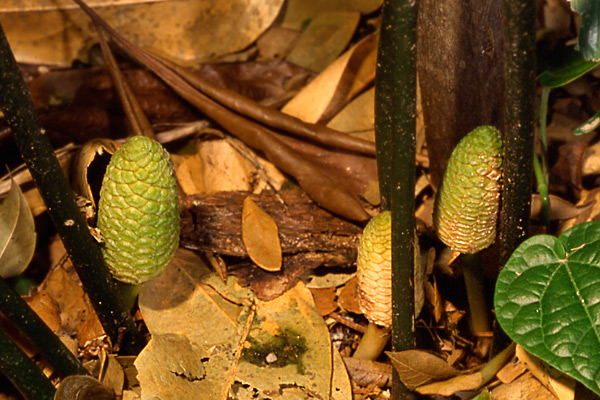General Description:
Despite the common name and their fern-like appearance, the three species in the genus Bowenia are part of a very ancient group of plants known as cycads. Bowenia is endemic to eastern districts of Queensland and like all cycads they do not produce flowers and reproduce by means of cones borne on separate male and female plants.
Bowenia species are distinctive among cycads in having bipinnate leaves (ie. twice divided pinnately). The Byfield fern, Bowenia serrulata, is the best known species.
Bowenia spectabilis is a plant with arching leaves arising from an underground stem. The mature leaves are fern-like and may reach 1-2 metres long and are dark, glossy green in colour. Immature leaves are light green. The margins of the leaflets are not serrated, a feature which distinguishes this species from B.serrulata. The male cones are ovoid in shape up to 60 mm long by about 30 mm wide and brownish in colour. Female cones are barrel shaped to about 120 mm x 90 mm. When ripe, the cone on the female plant breaks apart to release the large, cream or pinkish seeds.
In common with all cycads, the plants contain toxic compounds which are can result in poisoning if the leaves or seeds are eaten.
B.spectabilis is an attractive plant for cultivation and has proven to be hardy in tropical and sub-tropical areas in moist, semi-shaded or shaded positions. It may also be suitable for temperate climates in frost-free areas. However, the plant is very slow growing.
Propagation is from seed which germinates without the need for any pretreatment. However, germination may take up to 12 months
For further information on cycads and their cultivation see:
- Cycads of the World (2000); David L. Jones, Reed New Holland, Australia.
- The Cycad Pages
- Cultivation of Australian Cycads

Bowenia spectabilis
Photo: Brian Walters

Bowenia spectabilis; female cones
Photo: Brian Walters
 Australian Native Plants Society (Australia)
Australian Native Plants Society (Australia)